Electron–Phonon Temperature Inversion in Nanostructures under Pulsed Photoexcitation
IF 3.3
3区 化学
Q2 CHEMISTRY, PHYSICAL
引用次数: 0
Abstract
Photoexcitation of metallic nanostructures with short optical pulses can drive nonthermal electronic states, which, upon decay, lead to elevated electronic temperatures (Te ≳ 1000 K), eventually equilibrating with the lattice (Tp) through electron–phonon scattering. Here, we show that in spatially extended nanostructures the lattice temperature can locally exceed that of the electrons, a seemingly counterintuitive transient effect, termed hereafter “temperature inversion” (Tp > Te). This phenomenon, fundamentally due to inhomogeneous absorption patterns and absent in smaller particles, emerges from a complex spatiotemporal interplay between the electron–phonon coupling and competing electronic thermal diffusion. By combining rigorous three-dimensional (3D) finite-element-method-based simulations with practical reduced analytical models, we identify the electron–phonon coupling coefficient (Ge–p) as the critical parameter governing this behavior. An optimal Ge–p range allows inversion, whereas a weak or overly strong coupling suppresses it. Among common plasmonic metals, platinum exhibits the most pronounced and long-lived inversion, while gold and silver show no significant inversion. Moreover, the close agreement between the analytical model and 3D results, once an appropriate characteristic length is selected, highlights that the essential physics governing the inversion can be captured without full spatial complexity. These results provide insights for optimizing nanoscale energy transfer and hot-carrier-driven processes, guiding the strategic design of materials, geometries, and excitation conditions for enhanced ultrafast photothermal control.

脉冲光激发下纳米结构中的电子-声子温度反转
用短光脉冲激发金属纳米结构可以驱动非热电子态,这些电子态在衰变时导致电子温度升高(Te > 1000 K),最终通过电子-声子散射与晶格(Tp)平衡。在这里,我们证明了在空间扩展的纳米结构中,晶格温度可以局部超过电子的温度,这是一种看似违反直觉的瞬态效应,下文称为“温度反转”(Tp >;Te)。这种现象主要是由于不均匀的吸收模式,在较小的粒子中不存在,它是由电子-声子耦合和竞争电子热扩散之间复杂的时空相互作用产生的。通过将严格的三维(3D)有限元方法模拟与实际的简化分析模型相结合,我们确定电子-声子耦合系数(Ge-p)是控制这种行为的关键参数。最佳的Ge-p范围允许反转,而弱耦合或过强耦合则抑制反转。在常见的等离子体金属中,铂表现出最明显且寿命最长的反转,而金和银则没有明显的反转。此外,一旦选择了适当的特征长度,分析模型和3D结果之间的密切一致性突出表明,可以在没有完整空间复杂性的情况下捕获控制反演的基本物理。这些结果为优化纳米级能量传递和热载流子驱动过程提供了见解,指导了材料、几何形状和激发条件的战略设计,以增强超快光热控制。
本文章由计算机程序翻译,如有差异,请以英文原文为准。
求助全文
约1分钟内获得全文
求助全文
来源期刊

The Journal of Physical Chemistry C
化学-材料科学:综合
CiteScore
6.50
自引率
8.10%
发文量
2047
审稿时长
1.8 months
期刊介绍:
The Journal of Physical Chemistry A/B/C is devoted to reporting new and original experimental and theoretical basic research of interest to physical chemists, biophysical chemists, and chemical physicists.
 求助内容:
求助内容: 应助结果提醒方式:
应助结果提醒方式:


